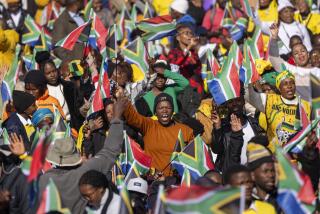Fate of Shuttered Hotel May Be Test of S. African Race Relations
- Share via
JOHANNESBURG, South Africa — Back in 1895, mining magnate Barney Barnato deemed that a place as prosperous as Johannesburg--then a booming gold-rush town--needed a world-class hotel to flaunt its success.
Barnato bought a block of land at Eloff and Commissioner streets, and although his untimely death and the Boer War delayed plans, the luxury Carlton Hotel opened its doors a decade later.
“The entire white staff, comprising 128 men and 58 women, was brought from London on a specially chartered liner, the Cluny Castle,” Nigel Mandy, a former Carlton executive, wrote in a history of Johannesburg. “The six-story hotel not only had . . . a telephone in every room, but also an early form of air-conditioning.”
Ever since its 1906 debut, the Carlton has been synonymous with downtown Johannesburg’s good fortune--the most glittering address in a town literally built on the glitter of gold. Even its owner, Anglo American Corp., is South Africa’s biggest mining conglomerate.
But the Carlton is no more. In the past few weeks, its revolving doors have been bricked shut and its elegant circular driveway cordoned with iron fencing. The fixtures in its gleaming marble lobby and award-winning restaurants are being inventoried for auction. The ballroom where President Nelson Mandela celebrated his 1994 election victory is empty and dark.
“We were losing money hand over fist,” said Brian Azizollahoff, a senior executive with Anglo American Properties Services, which operated the hotel for its parent company. “There is no longer demand for accommodation in a five-star hotel in the central business district of Johannesburg.”
Like many mainstays of the former white establishment, the Carlton could not find its way amid what urban experts call the downtown’s “Africanization”-- known in the vernacular as white flight.
In the bleakest days of racial separation, blacks were not even allowed in the center city after dark; today it is open to everyone around the clock. With the demographic changes have come problems of urbanization known worldwide--but kept at a distance here by apartheid-era restrictions--including skyrocketing crime, widespread squalor, homelessness and unchecked street vending.
The hotel’s posh shopping mall remains open but about a third of its stores are empty, despite a new campaign that markets it as “part of the African family.” An accompanying 50-story office tower has lost half of its tenants to the mostly white northern suburbs.
“We have to accept that there is a new face in town compared to 10 years ago,” said Dave Kavanagh, who manages the shopping center. “Most of the white-controlled businesses have moved to the suburbs, and the black population is using the city for their needs. Once their disposable income improves, things will turn around.”
The hotel had been on its deathbed for some time. In its last year, the grand dame of downtown establishments lost more than $4 million. In December, its main 600-room structure--built in 1971--was closed, as were its two flagship restaurants and banquet facility. The hotel limped along until last month, putting guests in a 63-room annex while hoping to win a gambling license from the provincial government. When the license was awarded elsewhere, management surrendered.
Azizollahoff said Anglo American is negotiating with an undisclosed U.S.-based company to sell the 30-story hotel, 50-story office tower and three-story shopping mall for about $8.5 million. A decade ago, the property was valued at 30 times that amount.
All of Johannesburg will be watching the deal; many urbanologists see the central business district as a test case for race relations and economic transformation across South Africa.
“The city center has become the critical point of integration, between black and white, rich and poor and, to many, order and disorder,” Richard Tomlinson of Witwatersrand University wrote in an analysis of downtown.
“It is my belief that in broad symbolic terms, in South Africa or perhaps in all sub-Saharan Africa, it is in central Johannesburg where the success of this integration will be measured.”
Jaine Roberts in The Times’ Johannesburg Bureau contributed to this report.
More to Read
Sign up for The Wild
We’ll help you find the best places to hike, bike and run, as well as the perfect silent spots for meditation and yoga.
You may occasionally receive promotional content from the Los Angeles Times.






